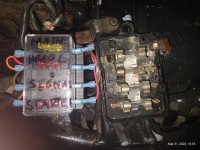Hello, first post on the forums and was looking for some advice.
Last fall I obtained my first street bike, 1982 xs400 heritage special. It was my boss's, she rode it a little bit a few years ago, had a kid, and quit riding it. It sat in the garage for 4 years and her husband recently took the carbs off and sent them to a friend for cleaning to get the bike running again.
They got a divorce, she said if I could haul the bike away it was mine, and the carbs were never seen again and never will be
So the weather here in Michigan is just starting to break and I am getting the urge to get this bike running and take my very first ride down the road on my first bike. But I've run into some problems with my original plan, "buy carbs off eBay, rebuild, grease and inspect everything, ride."
My vin number and title shows the bike is a 1982 xs400. But the stamp on the engine says 360cc. I do not know much about Yamahas (Honda ATV guy), could this be a swapped in engine?
Distinguishing factors I know about my bike:
-Spoked wheels
-Manual drum brakes front and back
-Electric start, glass fuses (will be upgraded to modern fuse block)
-Six speed, 1-N-2-3-4-5-6
My questions for the experts:
-Were the 400's only bored to 360cc? I thought there was a separate bike, the xs360, is that bored smaller or do I have an xs360 engine in my xs400?
-Consequently, should I order carbs for the xs360 or xs400 for this bike?
-Mike's XS has a "performance" new carb kit that includes intake manifold, throttle cable, and nice filters for a price cheaper than used carbs and rebuild kits... would it be foolish to toss a non-stock setup onto a non-running bike? It would be so much easier as I need intake manifolds and a cable anyways, and it's all in one neat kit for a decent price.
Thank you for all your help, this is my first street bike and first Yamaha and I am super excited to learn the ropes on it. I am relatively mechanically inclined with engines from cars and bikes, but these decisions stump me a little bit since google doesn't offer much good information on these bikes and their differences.
Attached are a few pictures of the dusty bike when I brought it home. If engine numbers or close up photos are needed I'll grab them right away! Apologies for my girlfriend's judgemental face, she wasn't the happiest to be woken from a nap to unload a dirty motorcycle I brought home.


Last fall I obtained my first street bike, 1982 xs400 heritage special. It was my boss's, she rode it a little bit a few years ago, had a kid, and quit riding it. It sat in the garage for 4 years and her husband recently took the carbs off and sent them to a friend for cleaning to get the bike running again.
They got a divorce, she said if I could haul the bike away it was mine, and the carbs were never seen again and never will be
So the weather here in Michigan is just starting to break and I am getting the urge to get this bike running and take my very first ride down the road on my first bike. But I've run into some problems with my original plan, "buy carbs off eBay, rebuild, grease and inspect everything, ride."
My vin number and title shows the bike is a 1982 xs400. But the stamp on the engine says 360cc. I do not know much about Yamahas (Honda ATV guy), could this be a swapped in engine?
Distinguishing factors I know about my bike:
-Spoked wheels
-Manual drum brakes front and back
-Electric start, glass fuses (will be upgraded to modern fuse block)
-Six speed, 1-N-2-3-4-5-6
My questions for the experts:
-Were the 400's only bored to 360cc? I thought there was a separate bike, the xs360, is that bored smaller or do I have an xs360 engine in my xs400?
-Consequently, should I order carbs for the xs360 or xs400 for this bike?
-Mike's XS has a "performance" new carb kit that includes intake manifold, throttle cable, and nice filters for a price cheaper than used carbs and rebuild kits... would it be foolish to toss a non-stock setup onto a non-running bike? It would be so much easier as I need intake manifolds and a cable anyways, and it's all in one neat kit for a decent price.
Thank you for all your help, this is my first street bike and first Yamaha and I am super excited to learn the ropes on it. I am relatively mechanically inclined with engines from cars and bikes, but these decisions stump me a little bit since google doesn't offer much good information on these bikes and their differences.
Attached are a few pictures of the dusty bike when I brought it home. If engine numbers or close up photos are needed I'll grab them right away! Apologies for my girlfriend's judgemental face, she wasn't the happiest to be woken from a nap to unload a dirty motorcycle I brought home.

